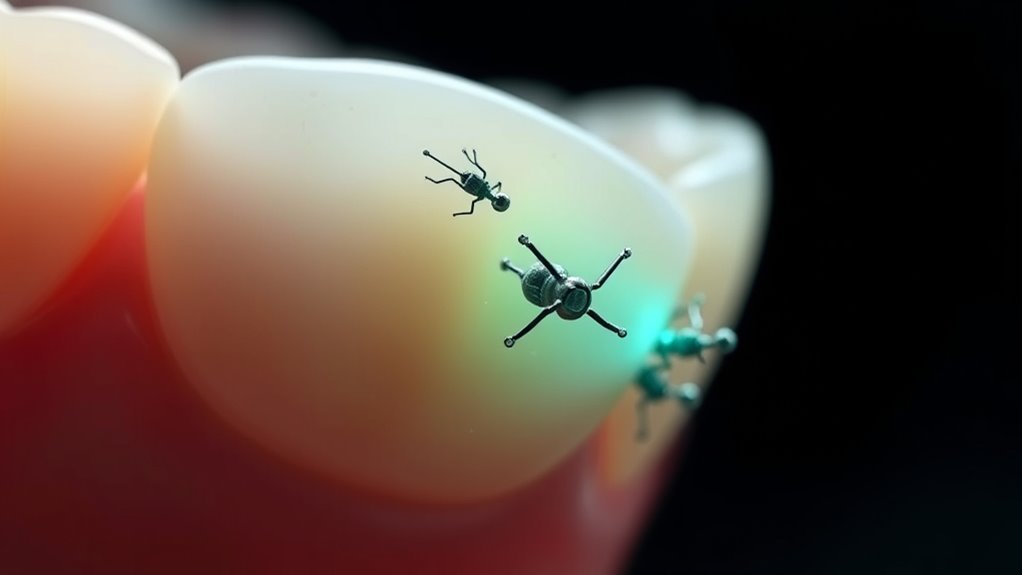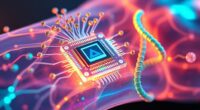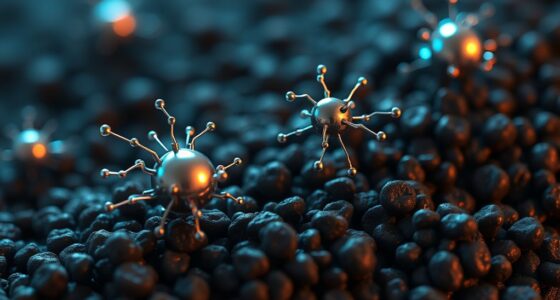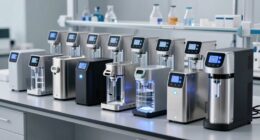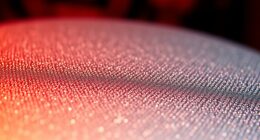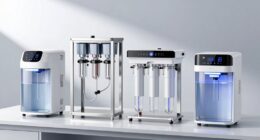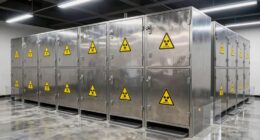Nanomachines in dental care offer targeted cleaning and tissue regeneration at a microscopic level. They can effectively remove plaque, bacteria, and debris from hard-to-reach areas while identifying and eliminating harmful microbes. These tiny tools also promote faster healing by delivering growth factors and mimicking natural tissue. With ongoing advances, you’ll discover how these innovations could transform your oral health by enabling less invasive, more precise treatments that support long-term dental wellness.
Key Takeaways
- Nanomachines provide targeted cleaning of plaque and bacteria in hard-to-reach areas, enhancing oral hygiene.
- They deliver antimicrobial agents directly to specific sites, reducing cavities and gum disease.
- Nanotechnology enables tissue regeneration by guiding cell growth and delivering growth factors for faster healing.
- These devices operate through controlled movements and molecular recognition, ensuring precise and safe dental treatments.
- Future advances include real-time detection of dental issues and minimally invasive regenerative therapies.
How Nanomachines Enhance Oral Hygiene
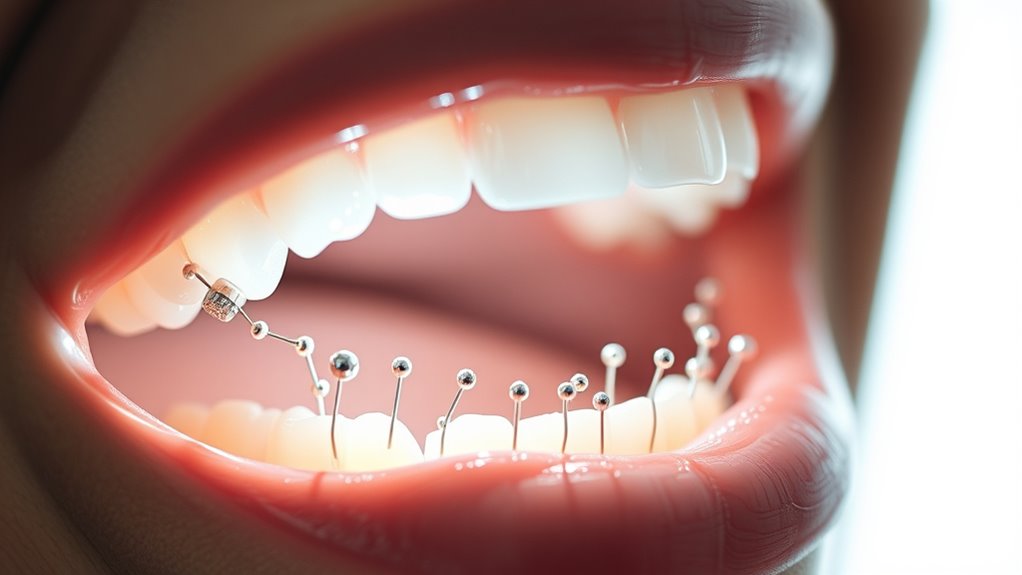
Nanomachines are revolutionizing oral hygiene by providing targeted and efficient cleaning at a microscopic level. You can better remove plaque and bacteria that hide in hard-to-reach areas, which traditional tools might miss. These tiny devices can navigate between teeth and along gum lines, breaking down stubborn deposits without damaging tissue. They work actively to identify and eliminate harmful microbes, reducing the risk of cavities and gum disease. Because nanomachines operate precisely, you get a deeper clean with less abrasion. This technology also allows for continuous monitoring of your oral health, alerting you to issues early. Additionally, nanomachines can be programmed to deliver essential oils directly to specific areas, enhancing antimicrobial action and promoting healing. Overall, nanomachines make daily dental care more effective, personalized, and less invasive, helping you maintain healthier teeth and gums with less effort.
Advances in Tissue Regeneration With Nanotechnology
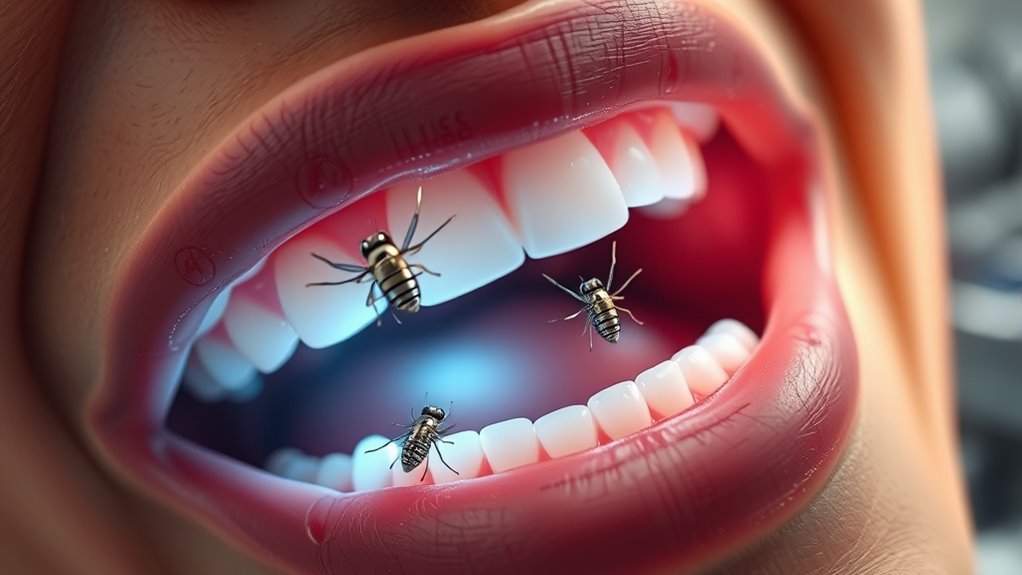
Recent advances in nanotechnology are transforming tissue regeneration in dental care, allowing for more precise and effective repair of damaged tissues. Nanomaterials can target specific cells, promoting faster healing and reducing scarring. For example, nanostructured scaffolds mimic natural tissue architecture, guiding cell growth and differentiation. Nanoparticles deliver growth factors directly to injury sites, enhancing regeneration processes. You benefit from minimally invasive procedures that restore functionality and aesthetics more efficiently. These innovations also enable the regeneration of complex structures like periodontal tissues and even dentin. As nanotechnology progresses, you can expect personalized treatments tailored to your specific needs, leading to improved recovery times and long-lasting results. The integration of nanomaterials marks a significant step toward fully regenerative, durable dental tissues. Relationships – Personality Test
The Science Behind Nanomachine Functionality in Dentistry
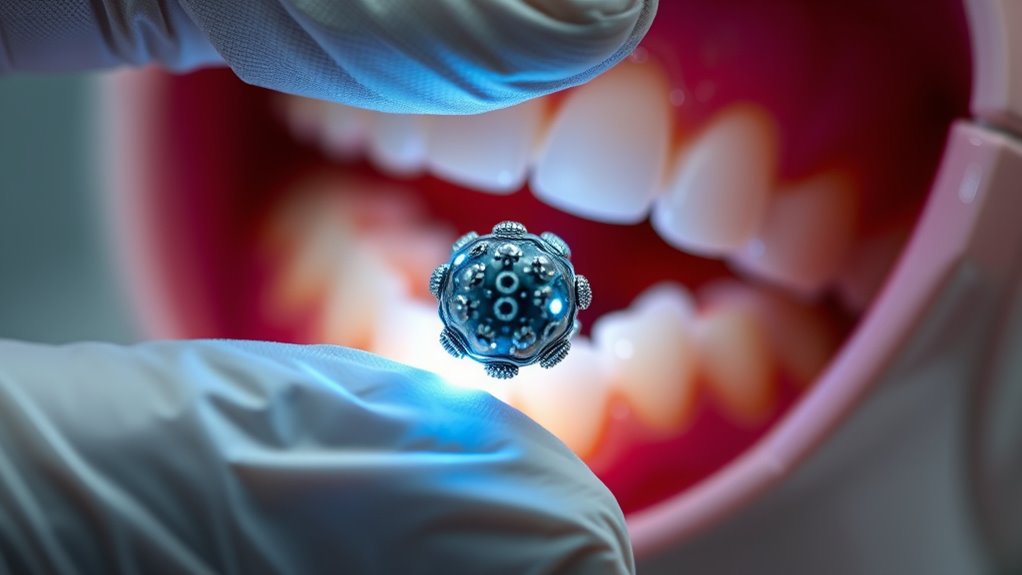
Understanding how nanomachines work in dentistry requires a grasp of their precise design and control at the molecular level. These tiny devices are engineered with specific structures that enable them to recognize and interact with targeted molecules, like plaque or damaged tissue. They operate through controlled movements driven by chemical or electrical signals, allowing them to perform tasks such as cleaning, repairing, or regenerating tissues. Nanomachines use molecular switches and motors to navigate complex oral environments accurately. Their design ensures high specificity, minimizing harm to surrounding healthy tissue. By harnessing the principles of nanotechnology, these devices can perform complex functions with unmatched precision, revolutionizing dental care. Additionally, advancements in projector technology have provided insights into how precise control mechanisms can be optimized for various applications. The science behind their operation combines chemistry, physics, and biology to create highly sophisticated, responsive tools for oral health management.
Benefits and Challenges of Using Nanomachines in Dental Treatments
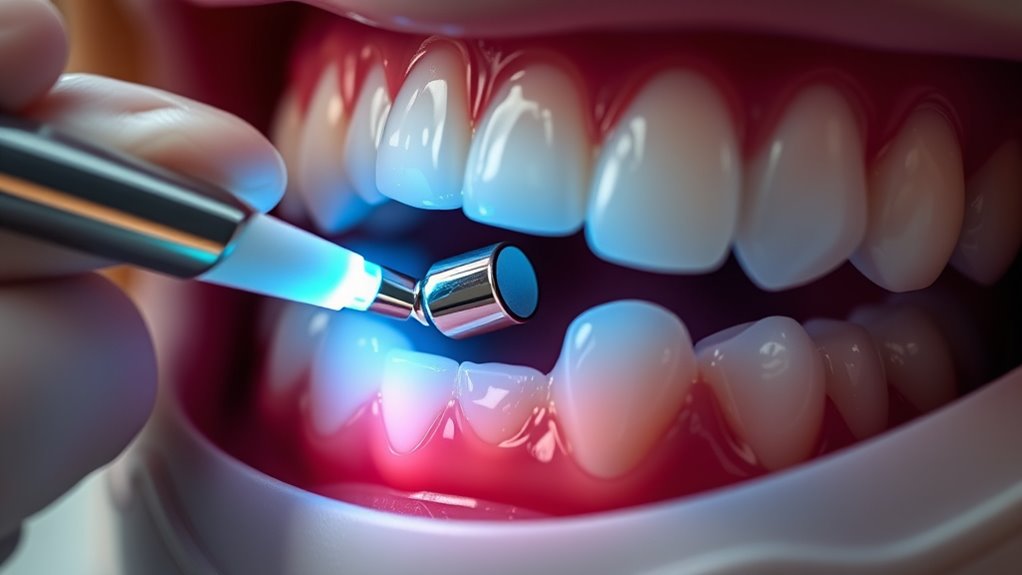
The integration of nanomachines into dental treatments offers significant advantages, such as increased precision in targeting plaque, decay, and damaged tissues, which can lead to more effective and less invasive procedures. However, challenges remain, including potential safety concerns, high development costs, and the need for specialized training. You must consider that nanomachines could:
- Cause unforeseen biological reactions
- Be expensive to produce and implement
- Require new protocols for safe use and maintenance
- Benefit from remote hackathons that foster innovation in medical nanotechnology and accelerate research collaborations
Despite these hurdles, the benefits like minimally invasive treatments, faster healing, and improved oral health outcomes make nanomachines a promising tool. Balancing these advantages with careful regulation and ongoing research is vital for successful integration into dentistry.
Future Perspectives on Nanotechnology in Oral Healthcare
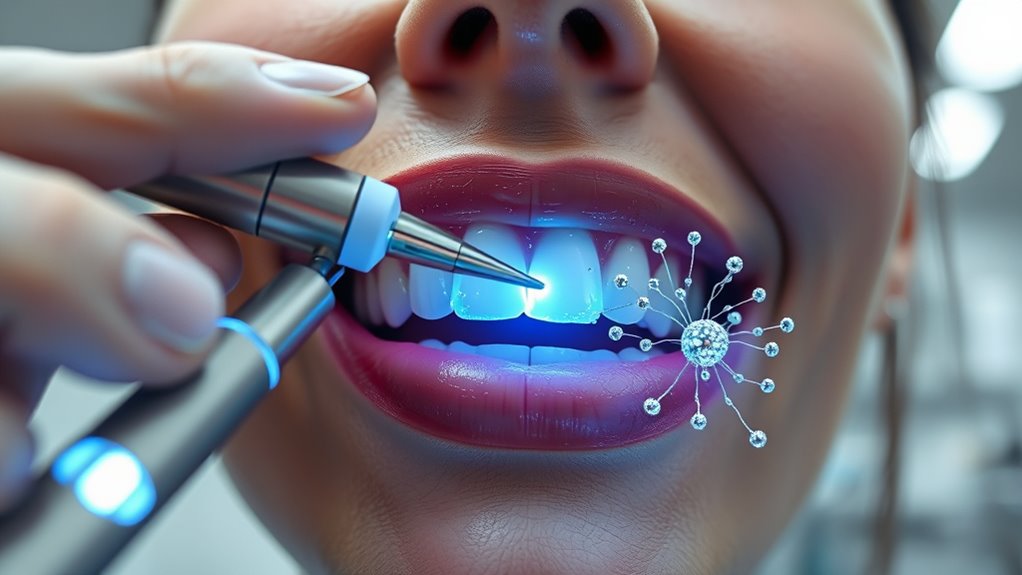
How will advances in nanotechnology shape the future of oral healthcare? You can expect personalized treatments tailored to your unique dental needs, using nanomachines that target specific bacteria or repair tissues at the cellular level. These innovations could enable real-time detection of cavities, infections, or inflammation, allowing for immediate intervention. As materials become smarter and more biocompatible, your dental care experiences will become less invasive and more effective. Nanotechnology might also facilitate regenerative therapies, helping to grow new enamel or restore damaged gums naturally. With ongoing research, you’ll likely see faster, safer, and more affordable solutions that improve oral health outcomes. The future holds the promise of smarter, more proactive dental care that seamlessly integrates into your daily routine, especially as AI security technologies ensure data privacy and safety.
Frequently Asked Questions
What Are the Potential Long-Term Health Effects of Dental Nanomachines?
The long-term health effects of dental nanomachines could include improved oral health, reduced infections, and faster healing. However, you might also face potential risks like immune reactions or unintended tissue damage if the nanomachines malfunction. It is crucial to monitor ongoing research and regulatory updates, as these tiny devices are new technology. Staying informed ensures you understand both the benefits and possible risks associated with dental nanomachines over time.
How Cost-Effective Are Nanomachines Compared to Traditional Dental Treatments?
Nanomachines could be more cost-effective over time because they perform precise, targeted treatments that reduce the need for multiple visits and invasive procedures. While initial costs might be higher, their efficiency saves you money long-term by preventing complications and lowering the need for extensive repairs. As technology advances and production costs decrease, nanomachines are likely to become an affordable, practical alternative to traditional dental treatments.
Can Nanomachines Be Customized for Individual Patient Needs?
Yes, nanomachines can be customized to fit your individual dental needs. Researchers are developing adaptable nanodevices that can target specific bacteria, repair damaged tissue, or regenerate enamel based on your unique oral health profile. This personalized approach guarantees more effective treatment, minimizes side effects, and enhances comfort. As technology advances, you’ll likely see increasingly tailored nanomachines that address your specific dental concerns more precisely than traditional methods.
What Are the Ethical Considerations Surrounding Nanotechnology in Dentistry?
Ethical considerations around nanotechnology in dentistry are like a tightrope walk—you must balance innovation with responsibility. You should think about patient safety, informed consent, and privacy, since nanomachines could access sensitive data or cause unintended harm. You also need to contemplate long-term impacts and equitable access, ensuring everyone benefits without exploitation. As you weigh these factors, responsible use guides you toward ethical, safe, and fair dental advancements.
How Do Nanomachines Interact With Existing Dental Materials and Restorations?
Nanomachines interact with existing dental materials and restorations by bonding at a microscopic level, enhancing their durability and functionality. You’ll find that they can target specific areas for cleaning or regeneration without damaging surrounding tissues. These tiny devices adapt to different materials, like composites or ceramics, ensuring seamless integration. As a result, they improve the longevity of restorations and promote healthier, more resilient dental work with minimal invasiveness.
Conclusion
With nanomachines revolutionizing dental care, you’re on the brink of a future where cavities and gum disease could become things of the past. These tiny marvels will transform your oral health, making treatments faster, more effective, and virtually painless. Imagine a world where your smile stays perfect forever—nanotechnology is making that dream a reality. Embrace this incredible innovation, because it’s truly a leap toward a healthier, brighter future that could change lives beyond your wildest imagination.
